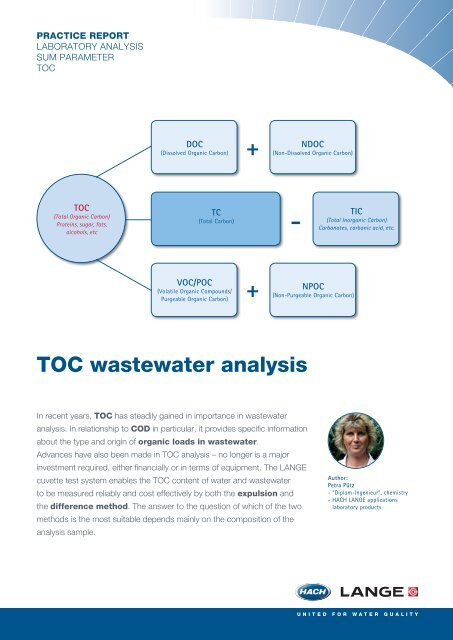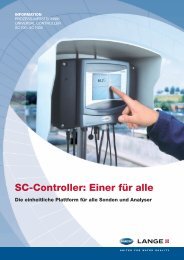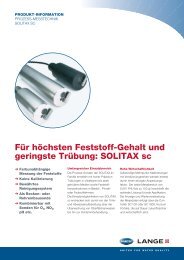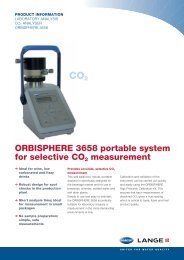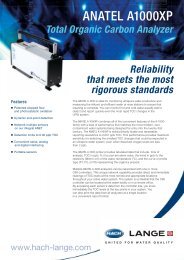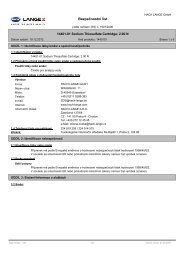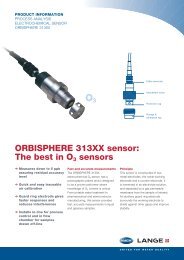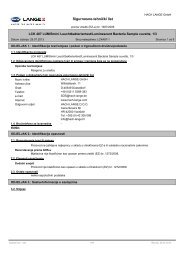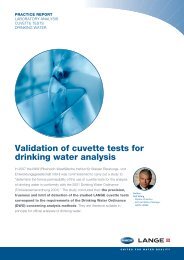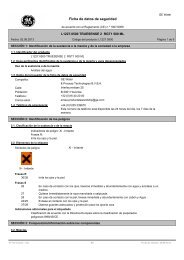TOC wastewater analysis - HACH LANGE
TOC wastewater analysis - HACH LANGE
TOC wastewater analysis - HACH LANGE
Create successful ePaper yourself
Turn your PDF publications into a flip-book with our unique Google optimized e-Paper software.
PRACTICE REPORT<br />
LABORATORY ANALYSIS<br />
SUM PARAMETER<br />
<strong>TOC</strong><br />
DOC<br />
(Dissolved Organic Carbon)<br />
+<br />
NDOC<br />
(Non-Dissolved Organic Carbon)<br />
<strong>TOC</strong><br />
(Total Organic Carbon)<br />
Proteins, sugar, fats,<br />
alcohols, etc<br />
TC<br />
(Total Carbon)<br />
-<br />
TIC<br />
(Total Inorganic Carbon)<br />
Carbonates, carbonic acid, etc.<br />
VOC/POC<br />
(Volatile Organic Compounds/<br />
Purgeable Organic Carbon)<br />
+<br />
NPOC<br />
(Non-Purgeable Organic Carbon)<br />
<strong>TOC</strong> <strong>wastewater</strong> <strong>analysis</strong><br />
In recent years, <strong>TOC</strong> has steadily gained in importance in <strong>wastewater</strong><br />
<strong>analysis</strong>. In relationship to COD in particular, it provides specific information<br />
about the type and origin of organic loads in <strong>wastewater</strong>.<br />
Advances have also been made in <strong>TOC</strong> <strong>analysis</strong> – no longer is a major<br />
investment required, either financially or in terms of equipment. The <strong>LANGE</strong><br />
cuvette test system enables the <strong>TOC</strong> content of water and <strong>wastewater</strong><br />
to be measured reliably and cost effectively by both the expulsion and<br />
the difference method. The answer to the question of which of the two<br />
methods is the most suitable depends mainly on the composition of the<br />
<strong>analysis</strong> sample.<br />
Author:<br />
Petra Pütz<br />
- “Diplom-Ingenieur”, chemistry<br />
- <strong>HACH</strong> <strong>LANGE</strong> applications<br />
laboratory products
2<br />
<strong>TOC</strong>_CONNECTIONS<br />
<strong>TOC</strong> <strong>analysis</strong>: expulsion or difference<br />
method?<br />
Expulsion method<br />
The <strong>TOC</strong> is determined directly with just one<br />
measurement after the inorganic carbon (TIC)<br />
has been completely expelled from the sample<br />
(acidification + expulsion).<br />
Especially suitable for samples with<br />
- A TIC content that is much higher than<br />
their <strong>TOC</strong> content<br />
- A very low TIC content<br />
- A low <strong>TOC</strong> content<br />
Fig. 1: <strong>TOC</strong> determination by the expulsion<br />
method<br />
Difference method<br />
This involves two measurements, i.e. total<br />
carbon (TC) and total inorganic carbon (TIC).<br />
The <strong>TOC</strong> is then calculated as the difference<br />
between TC and TIC (<strong>TOC</strong> = TC - TIC).<br />
Especially suitable for samples<br />
- That contain volatile organic compounds<br />
(VOC)<br />
- With a <strong>TOC</strong> content that is equal to or<br />
greater than their TIC content<br />
Fig. 2: <strong>TOC</strong> determination by the difference<br />
method<br />
What does <strong>TOC</strong> tell us?<br />
<strong>TOC</strong> (Total Organic Carbon, see Fig. 1)<br />
is, alongside or in association with COD<br />
and BOD 5<br />
, an important sum parameter<br />
for assessing the organic load of water.<br />
As all organic carbon compounds are<br />
determined and specified in terms<br />
of carbon mass, <strong>TOC</strong> is an exactly<br />
definable absolute quantity and is<br />
directly measurable (unit: mg C/l).<br />
<strong>TOC</strong> on its own sheds no light on the<br />
oxidisability of the measured carbon<br />
or the amount of oxygen needed<br />
for its biodegradation. However, the<br />
ratio COD:<strong>TOC</strong> provides important<br />
information about the presence of<br />
certain organic compounds (e.g.<br />
alcohols, proteins, etc.). If this ratio<br />
changes, e.g. in the inflow of a sewage<br />
treatment plant, conclusions can be<br />
drawn immediately about the causes,<br />
and the possible effects on biological<br />
processes in the sewage treatment<br />
plant.<br />
Legal requirements<br />
According to the EU Council Directive<br />
concerning urban waste water<br />
treatment, BOD 5<br />
can be replaced as<br />
a monitoring parameter by <strong>TOC</strong> if a<br />
relationship can be established between<br />
the two parameters.<br />
In some European countries, <strong>TOC</strong><br />
has replaced COD as a monitoring<br />
parameter. In Germany, for example,<br />
<strong>TOC</strong> is officially used as a screening<br />
test in the context of COD monitoring of<br />
municipal <strong>wastewater</strong>. The COD of the<br />
<strong>wastewater</strong> is regarded as satisfactory if<br />
the <strong>TOC</strong> (in mg/l), multiplied by 4, does<br />
not exceed the COD limit value.<br />
A basic problem associated with the<br />
switch from COD to <strong>TOC</strong>, however,<br />
is the often widely varying conversion<br />
factor. Depending on the composition<br />
of the <strong>wastewater</strong>, this factor can be<br />
between two and six.<br />
<strong>TOC</strong> <strong>analysis</strong>: choice of method<br />
All methods of measuring <strong>TOC</strong> are<br />
based on the thermal or wet chemical<br />
oxidation of organic carbon to carbon<br />
dioxide (CO 2<br />
). The carbon dioxide is<br />
detected and quantitatively determined.<br />
A distinction is made between two<br />
methods: the expulsion method and<br />
the difference method (see Figs.<br />
1 + 2). The European standard EN<br />
1484 refers to them both as equivalent<br />
reference methods. The choice of which<br />
method to use should be made on the<br />
basis of the composition of the sample.<br />
If, for example, the sample contains<br />
a large amount of volatile organic<br />
compounds (VOC), these will not be<br />
measured by the expulsion method<br />
(low-bias results).<br />
The two methods may therefore<br />
provide widely different results for the<br />
same sample (due to the presence<br />
of VOC, or to unfavourable TC/TIC<br />
ratios). The method to be used for<br />
comparative measurements should<br />
therefore be agreed beforehand with, for<br />
example, supervisory bodies or external<br />
laboratories.<br />
The comparability of <strong>TOC</strong> results<br />
usually depends not on the<br />
procedure but on the chosen<br />
measurement method (expulsion<br />
or difference method)<br />
www.hach-lange.com
3<br />
<strong>TOC</strong> cuvette test<br />
If average numbers of samples have<br />
to be analysed, cuvette tests are the<br />
simplest and most cost-effective option.<br />
The chemicals and photometer are<br />
factory-calibrated and are therefore<br />
ready for immediate use.<br />
A wet chemical oxidative digestion is<br />
carried out, followed by photometric<br />
determination of the liberated carbon<br />
dioxide. The CO 2<br />
passes from the<br />
digestion cuvette through a gaspermeable<br />
membrane and into an<br />
indicator cuvette. The resulting colour<br />
change in the indicator is evaluated<br />
photometrically (see Fig. 3).<br />
A big advantage of this method is that<br />
even turbid, particle containing and<br />
coloured samples can be analysed<br />
without difficulty, as only the colour<br />
change in the indicator cuvette is<br />
measured.<br />
The expulsion method requires the<br />
inorganic carbon (TIC) to be expelled<br />
from the sample before the digestion is<br />
carried out. The <strong>TOC</strong>-X5 shaker is used<br />
for this. The sample is simply pipetted<br />
into the digestion cuvette and the open<br />
cuvette is positioned in the shaker. The<br />
combination of shaker and fan drives all<br />
the TIC out of up to eight samples within<br />
just five minutes.<br />
The cap is then screwed onto the<br />
indicator cuvette and the <strong>TOC</strong> digestion<br />
in the dry thermostat can begin.<br />
The shaker procedure saves time and is<br />
very uncomplicated and reliable from the<br />
point of view of handling.<br />
The correct amounts of all reagents<br />
are already present in the digestion<br />
cuvette.<br />
Analysis accessories do not need to<br />
be rinsed with <strong>TOC</strong>-free water.<br />
The three practical measuring<br />
ranges cover carbon concentrations<br />
from 3-3,000 mg/l, so that the<br />
homogenised sample can usually<br />
be analysed immediately, without<br />
any need for time-consuming prior<br />
dilution, which is also a potential<br />
source of error.<br />
2008 round robin test results<br />
A round robin test organised by the<br />
Swiss Office of Environment and<br />
Energy in 2008 showed how well the<br />
cuvette tests function in practice.<br />
Almost 50 participants analysed real<br />
water samples. The results speak for<br />
themselves: 91 % of the results obtained<br />
from the outflow samples and 92 %<br />
of the results from the inflow samples<br />
(LCK386) were correct (LCK385). In both<br />
cases, the standard deviation was below<br />
10 %.<br />
Depending on the<br />
carbon dioxide inflow,<br />
the indicator solution<br />
undergoes a more or<br />
less marked change in<br />
colour<br />
Double cap with CO 2<br />
-<br />
permeable membrane<br />
Sample + Reagent, 2 h<br />
at 100 °C<br />
Indicator cuvette<br />
Digestion cuvette<br />
Fig. 3: Functional principle of the <strong>LANGE</strong> <strong>TOC</strong><br />
cuvette test<br />
Fig. 4: Using the <strong>TOC</strong>-X5 shaker, the TIC is<br />
expelled in just five minutes – from up to 8<br />
samples simultaneously.<br />
Method Cuvette test Dangerous<br />
substance<br />
classification<br />
Expulsion<br />
method<br />
Difference<br />
method<br />
Measuring<br />
range<br />
(mg/l C)<br />
Sample<br />
preparation<br />
LCK385<br />
LCK386<br />
LCK387<br />
Xn<br />
Xn<br />
Xn, N<br />
3–30<br />
30–300<br />
300–3,000<br />
Homogenisation,<br />
expulsion,<br />
digestion<br />
LCK380 Xn, O 2–65 Homogenisation,<br />
LCK381 Xn, O 60–735 digestion<br />
Table 1: Overview of <strong>TOC</strong> cuvette tests<br />
<strong>HACH</strong> <strong>LANGE</strong><br />
accessories<br />
<strong>TOC</strong>-X5 shaker,<br />
thermostat,<br />
photometer<br />
Thermostat,<br />
photometer<br />
Hazard symbols<br />
Oxidising<br />
Harmfull<br />
Dangerous for the<br />
environment
<strong>TOC</strong>_COMPARABILITY<br />
Achieving accurate results!<br />
<strong>TOC</strong> results from IL 550 analyser [mg/l C]<br />
2000<br />
1500<br />
1000<br />
500<br />
0<br />
0 500 1000 1500 2000<br />
Excellent comparability<br />
The measurement results in Figure 5<br />
show that there is excellent comparability<br />
between the <strong>TOC</strong> cuvette test and the<br />
analyser. Real samples obtained from a<br />
variety of sources were determined by<br />
the expulsion method using a cuvette<br />
test and using the IL 550 <strong>TOC</strong> analyser.<br />
Comparative measurements obtained by<br />
the difference method give equally good<br />
results (not shown here).<br />
In practice, most users prefer the<br />
expulsion method, because the handling<br />
is simpler and faster. Moreover, the<br />
results obtained by the expulsion<br />
method usually show less scatter, as the<br />
<strong>TOC</strong> is determined directly (with only one<br />
measurement).<br />
Comparison of cuvette test and analyser<br />
<strong>TOC</strong> results from cuvette tests LCK385/386/387 [mg/l C]<br />
Fig. 5: Comparison of <strong>TOC</strong> measurement results from cuvette test and analyser (expulsion method)<br />
Fig. 6: Ideal for large numbers of samples – the<br />
IL 550 <strong>TOC</strong>-TN Analyser<br />
Literature<br />
- EU Directive of 21 May 1991 concerning<br />
urban waste water treatment (91/271/EEC)<br />
- European Standard 1484<br />
- <strong>HACH</strong> <strong>LANGE</strong> Practice report “<strong>TOC</strong>-Analytik<br />
im Abwasser”, June 2002 (DOC040.72.00197)<br />
- <strong>HACH</strong> <strong>LANGE</strong> Anwendungsbericht “Dr.<br />
Lange <strong>TOC</strong> Küvetten-Test entspricht der<br />
Europanorm”, May 1998 (DOC042.00.00153)<br />
<strong>TOC</strong> <strong>analysis</strong> is vitally important in<br />
applications ranging from power<br />
generation, <strong>wastewater</strong>, drinking water,<br />
surface water and ultrapure water, to<br />
agricultural soils, contaminated land and<br />
food. <strong>HACH</strong> <strong>LANGE</strong> analysers therefore<br />
offer a range of options designed to<br />
meet every need. For example, in the<br />
pharmaceutical industry the priority is for<br />
high accuracy and repeatability at very<br />
low levels, whilst <strong>analysis</strong> of <strong>wastewater</strong><br />
should be able to accommodate samples<br />
with high particle levels and salt<br />
concentrations. Analysis under these<br />
conditions is a unique feature of the<br />
<strong>HACH</strong> <strong>LANGE</strong> instruments.<br />
Matthew Dillon<br />
UK Sales Manager<br />
<strong>HACH</strong> <strong>LANGE</strong><br />
DOC042.52.20033.Apr09<br />
<strong>HACH</strong> <strong>LANGE</strong> MAROC SARLAU<br />
Villa 14 – Rue 2 Casa Plaisance<br />
Quartier Racine Extension<br />
MA-Casablanca 20000<br />
Tél. +212 (0)522 97 95 75<br />
Fax +212 (0)522 36 89 34<br />
info-maroc@hach-lange.com<br />
www.hach-lange.ma<br />
Tél. +212 (0)522 97 95 75


